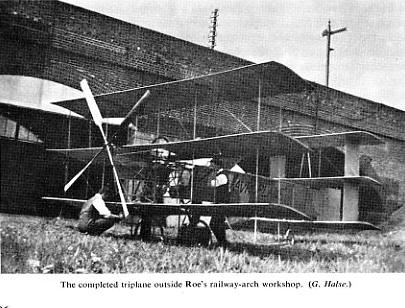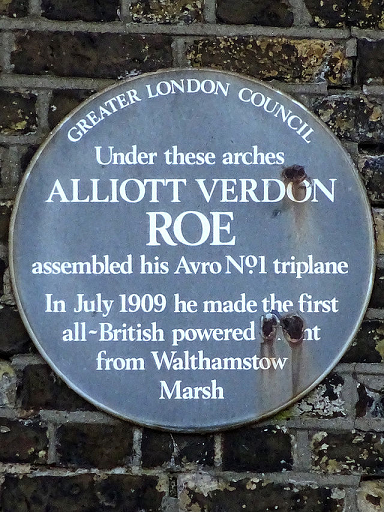Lea Marshes
Note: Years ago Lea Marshes referred to the entire area of marshes associated with the river Lea, and was regarded by most as being a worthless waste ground.
Today of course, since the area has been largely cleansed of industrial waste and effluents, it is being rejuvenated as an area offering an astonishing array of bio-diversity. And, in the process, it has been sub-divided into several seperate marsh areas.
Several years ago I made this plea: "If anybody knows where Alliott Verdon Roe was based in this area, this advice will be most welcome indeed."
In April 2020, Richard E. Flagg came to my help, providing the location and a picture of the plaque on the railway arches. Together with Paul Bingley they published in 2020 the book ESSEX: A Hidden Aviation History, which is quite probably the most authoritative and comprehensive account of this County.
LEA MARSHES: Early flying ground
Operated by: A.V. Roe
Location: Lammas Meadow
Period of operation: 1908 to 1909 only?
NOTES: Accordingly to some reliable sources Alliott Verdon Roe first flew very briefly, just a short ‘hop’ really, in 1906 but was this almost certainly in 1908 at BROOKLANDS?
Other opinions state that on the 13th July 1909 he became the first British subject to fly an all-British machine, the Roe Triplane, from LEA MARSHES covering some 30 metres (100ft). A few days later, on the 23rd of July it appears he then flew for 274 metres, (900ft), (some records say 984ft), a substantially greater distance than his attempt on the 13th of July. I would very much like to know what was actually considered to be a ‘controlled flight’ in those days? The Wright brothers barely managed a ‘hop’ in ground effect but they evenually got the ‘gong’ for being the first to fly a powered aircraft. However, the more I look into this the more questionable that decision seems. Indeed, it now appears that in other parts of the world the pilots of the day, experimenting with early powered flight, also placed little importance on 'hops' made in ground effect.
BANISHED
In 1908 Alliott Vernon Roe was banished from BROOKLANDS and cycled far and wide to find a suitable site. Eventually he applied to the Great Eastern Railway, and they allowed him to rent space in their arches. For the fuller story please read British Aviation - The Pioneer Years by Harald Penrose. It really is a fascinating account of how A V Roe surmounted so many obstacles in his quest to produce a practical aeroplane.
Note: These three pictures, the first two by Mr G Halse, were scanned from British Aviation - The Pioneer Years. As was the third picture. This was I think also taken at LEA MARSHES but could well be mistaken. Could anybody today offer advice? The take-off angle seems ridiculously steep and bound to end in a stall if not corrected.
The caption for the second picture is: "Roe (second from right) working on the square section fuselage of the first of his two triplanes at his workshop under the railway arches."
The fourth picture of the plaque was very kindly provided by Richard E. Flagg in 2020. But, he told me, he thinks it has now been restored.
A MOVE TO WEMBLEY PARK
Eventually opposition from Leyton Council for him using the area around the arches for flying experiments on common ground, forced a move. He found that, through contacts in the Aeroplane Club, the proprietors of Wembley Park were very much in favour of encouraging aviation activities. So he moved there.
SOME MORE INFORMATION
According to C C Turner in his book Old Flying Days published probably in 1927: “In 1908 he moved to Lea Marshes where he found a suitable railway arch for his workshop. Here, on his aeroplane fitted with a 9hp J.A.P. engine, which he had substituted for an Antionette, he made flights. He took this machine to the Blackpool meeting. I saw him fly at Lea Marshes, and often at Brooklands.”
It seems to me that the issue of photographic proof seems to be the real concern here and the Wright brothers certainly got that. But photographic proof of a short hop on a particular day actually means next to nothing regarding real proof of who really first managed a proper ‘controlled’ flight. Ironically the available proof today indicates that without too much doubt it was the Wright brothers who finally achieved this when they continued their experiments near Dayton, Ohio, in considerable secrecy.
As I understand it many early aviators did not regard the ‘first’ Wright brothers ‘flight’ as being in any way a proper controlled flight worthy of being regarded as such - it was far too short in distance and duration. However, once the ‘world’ press get hold of a story they consider to be ‘fact’ and it is therefore futile to argue otherwise. So little has changed in the last century in that respect at least!
What is without doubt is that the Wright brothers made a supreme contribution to early flight and due to their continous dedication and diligence, undoubtably perfected the first ever practical aeroplane which could be demonstrated far and wide and even used to safely carry passengers. This is surely a far more remarkable achievement than conducting a short hop at Kittyhawk in late 1903 and indeed, when they demonstrated their aeroplane at Le Mans, and elsewhere in France, the French pilots were astonished by just how proficient the Wright brothers were.
A REPLICA FLIES
In 2007 it was reported that BAe staff at Chadderton in LANCASHIRE, (once the Avro factory and possibly still known as such by many locals - it certainly was in the 1970s), were building a replica 1909 Avro Triplane to fly from LEA MARSHES in 2009. I wonder if they, (or someone), has managed to identify the original flying site - and if this site could still be used?
It always strikes me as odd that so much of aircraft manufacturing takes place well away from an airfield. But, when you study the subject of the actual process required in manufacturing aircraft it has almost nothing to do with the flying of the final result. Almost from the earliest days the history of the A V Roe company especially helps to illustrate this.
For example and in chronological order from 1908 the AVRO company flight-test locations were, and I believe this is generally agreed?: BROOKLANDS (1908), LEA MARSHES, WEMBLEY PARK, BROOKLANDS (1910), SHOREHAM, HAMBLE, ALEXANDRA PARK, WOODFORD, RINGWAY and YEADON.
On the other hand manufacturing by AVRO took place, in hopefully chronological order: At Putney (London), Brownsfield Mills, Miles Platting and Newton Heath (Manchester), HAMBLE in HAMPSHIRE, Chadderton (Manchester), WOODFORD CHESHIRE and later YEADON in YORKSHIRE. In WW2 component manufacturing facilities were situated at Ashton-under-Lyne, Failsworth, Royton and Wythenshawe - all in the Manchester area.
J S Piggott
This comment was written on: 2018-03-31 14:07:04My grandfather drowned in the river lea on August 4th 1914. I was told he committed suicide after being involved in some early flight experiments on Lea Marshes. Therewas an accident and he felt responsible. He was a carpenter as I understand it. Can you shed any light on this.
Reply from Dick Flute:
This request is posted by Jennifer Piggott. I wonder if anybody can kindly offer information?
Edward Bishop
This comment was written on: 2019-01-23 20:39:17My Grandfather, E B Ware, developed the JAP engine for A V Roe. I remember the story from my grandmother that she was very unhappy when "EB" told her he had flown from Hackney marshes. He died of cancer in 1939, but both his sons survived the war in the RAF, flying Lancasters and Sunderlands, as did his best friend, Ray Holmes, flying Hurricanes. See Ray's book, Sky Spy.
We'd love to hear from you, so please scroll down to leave a comment!
Leave a comment ...
Copyright (c) UK Airfield Guide



















